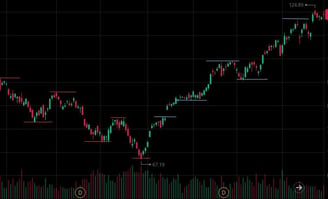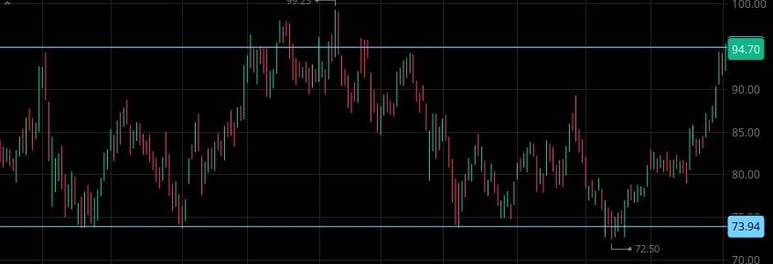Analysis
Technical Analysis
The stock market can only move in 3 distinct ways: Uptrend, Ranging, and Downtrend.
Using technical analysis will help you be able to distinct the direction and plan a trade accordingly to the general big trend of the move.
In a uptrend, the market is making a series of higher highs and higher lows as shown in the picture below. Vice versa for a downtrading market but instead it is making lower highs and lower lows. While range bound is when the market is trading in an area of consolidation which tends to bounce off of the same support/resistance multiple times before deciding to breakout in either side.


Can you spot the up-trend and the down-trend?
First the market moves down, and the peaks are lower than the previous peaks. Then it changes, and the market fails to make a new low. It also starts to make a series of higher highs and higher lows. The market has moved from an down-trend to a up-trend.


Now can you tell what the chart trend is on this chart?


No, you can’t and neither can I. It's best to assume there is no trend at all but rather consolidating. You can tell because the market is in a distinct channel where it keeps bouncing at key support and resistance levels. Eventually it will crack in either direction. To trade this typical setup is by buying at support and selling at resistance and putting a stop loss below the support level. Vice versa applies if you plan to short so sell at the high and buy at the low.
Identifying Market Reversals
To identify when an uptrending or downtrending market is starting to reverse, traders often look for certain patterns and signals. In an uptrend, a reversal might be indicated by a series of lower highs and lower lows, suggesting that the buying pressure is weakening and selling pressure is increasing. Candlestick patterns such as bearish engulfing or shooting stars at the top of an uptrend are also strong indicators of a potential reversal. Additionally, a divergence between price action and momentum indicators like the Relative Strength Index (RSI) can signal that the uptrend is losing strength. In a downtrend, a reversal can be identified by higher lows and higher highs, showing that the selling pressure is diminishing. Bullish candlestick patterns, such as bullish engulfing or hammer candles, at the bottom of a downtrend can also indicate a reversal. Again, divergence between price action and RSI or other momentum indicators can confirm a potential trend change.
Support and Resistance
Support and resistance levels are key components of technical analysis. Support is a price level where a downtrend can be expected to bounce/pause due to a concentration of buying interest. Resistance is a price level where an uptrend can be expected to reverse/pause due to huge selling interest. To mark key levels of support and resistance, traders look for price points where the market has respected a level in the past. These levels can be identified on various timeframes, from intraday charts to weekly charts, depending on the trader's strategy. Horizontal lines are drawn at these price points, and the more times a price level has been tested and held, the stronger it is considered to be. Identifying these levels helps traders to set entry and exit points, place stop-loss orders, and make more informed trading decisions.
Also, psychological support and resistance levels are important concepts to understand. These levels often occur at round numbers, which many traders see as significant. For higher-priced stocks, these levels typically appear at increments of $5 (like $10, $15, $20). For penny stocks, which are lower in price, these levels often occur at $0.50 or $1 increments (such as $0.50, $1.00, $1.50).
Why do these levels matter? Because they act like invisible barriers. Many traders place their buy or sell orders at these round numbers, which causes the stock price to either bounce back or break through these levels. For example, if a stock is approaching $20, many traders might sell, creating resistance. If it breaks through $20, it might continue to rise as new buyers step in.
Understanding these psychological levels helps you predict market movements. By watching how a stock reacts at these levels, you can make better decisions about when to enter or exit a trade. This is a valuable tool in your trading toolkit, helping you navigate the market more effectively.
Volume Weighted Average Price (VWAP)
The Volume Weighted Average Price (VWAP) is an essential indicator used to determine the average price a security has traded at throughout the day, based on both volume and price. VWAP is calculated by adding up the dollars traded for every transaction (price multiplied by number of shares traded) and then dividing by the total shares traded. Traders use VWAP to gauge the value of a security and to identify trading opportunities. When the price is below the VWAP, it indicates that the security might be undervalued, and when the price is above the VWAP, it indicates that it might be overvalued. VWAP acts as a support and resistance level; intraday traders often look for prices to revert to the VWAP, using it to make trading decisions.
Relative Strength Index (RSI)
The Relative Strength Index (RSI) is a momentum oscillator that measures the speed and change of price movements, typically over a 14-period timeframe. The RSI ranges from 0 to 100 and helps identify overbought or oversold conditions in a market. A reading above 70 generally indicates that a stock is overbought and may be due for a pullback or reversal, while a reading below 30 suggests that it is oversold and could be due for a rebound. Traders use RSI to spot potential entry and exit points, divergences, and confirmation of trends. For example, if the RSI forms lower highs while the price forms higher highs, it indicates a bearish divergence and a potential reversal. Conversely, a bullish divergence occurs when the RSI forms higher lows while the price forms lower lows.
Moving Averages (MA)
Moving averages (MA) are widely used in technical analysis to smooth out price data and identify trends over specific periods. The two most common types are the Simple Moving Average (SMA) and the Exponential Moving Average (EMA). The SMA calculates the average of a selected range of prices, usually closing prices, by the number of periods in that range. The EMA gives more weight to the most recent prices, making it more responsive to new information. Moving averages can be used to identify the direction of a trend, with a rising MA indicating an uptrend and a falling MA indicating a downtrend. Traders often use moving average crossovers to signal potential changes in market direction. For instance, a "golden cross" occurs when a short-term MA crosses above a long-term MA, signaling a potential bullish trend, while a "death cross" occurs when a short-term MA crosses below a long-term MA, signaling a potential bearish trend.
Moving Average Crossovers
Golden Cross: Occurs when a short-term MA (e.g., 50-day) crosses above a long-term MA (e.g., 200-day), signaling a potential bullish trend.
Death Cross: Occurs when a short-term MA crosses below a long-term MA, signaling a potential bearish trend.
9-day EMA: This is commonly used for setting stop-loss orders. Traders may use the 9-day EMA as a trailing stop, adjusting it daily to lock in profits or limit losses.
50-day and 200-day MA: These are widely followed moving averages used to identify long-term trends. The 50-day MA is often seen as a support or resistance level in trending markets, while the 200-day MA is considered a key indicator of the overall market direction. The crossover of the 50-day and 200-day MAs (golden or death cross) is closely watched by traders and investors for signals of major trend changes.
Fundamental Analysis
Method used to evaluate the value of a business, by examining related economic, financial, and other qualitative and quantitative factors. Unlike technical analysis, which focuses on price movements and trading volumes, fundamental analysis looks at the underlying factors that might influence an asset's value. This includes analyzing a company's financial statements, such as its income statement, balance sheet, and cash flow statement, to assess its financial health and performance.
In addition to financial metrics, fundamental analysis also considers broader economic indicators (FOMC, CPI, GDP), industry conditions, and company-specific factors like management quality, competitive advantages, and market position. The goal is to determine whether an asset is overvalued or undervalued compared to its current market price. By understanding the true value of an asset, investors can make more informed decisions about buying, holding, or selling it. This approach is often used by long-term investors who are looking to invest in companies with strong fundamentals that are likely to grow over time.
FOMC (Federal Open Market Committee):
The FOMC is responsible for setting monetary policy in the United States, including interest rates. Decisions made by the FOMC can significantly impact the economy and financial markets. For example, changes in interest rates can affect borrowing costs, consumer spending, and business investment. Investors closely monitor FOMC meetings and statements to gauge the future direction of monetary policy.
CPI (Consumer Price Index):
The CPI measures the average change in prices paid by consumers for goods and services over time. It is a key indicator of inflation. Rising CPI indicates increasing inflation, which can erode purchasing power and impact consumer spending. Inflation data is critical for investors as it can influence central bank policies, interest rates, and overall economic stability.
GDP (Gross Domestic Product):
GDP represents the total value of all goods and services produced within a country over a specific period. It is a broad measure of economic activity and health. Strong GDP growth indicates a robust economy, which can lead to higher corporate earnings and stock prices. Conversely, weak GDP growth may signal economic troubles and potential declines in asset values.
PPI (Producer Price Index):
The PPI measures the average change in selling prices received by domestic producers for their output. It is an indicator of inflation at the wholesale level. Rising PPI can signal increasing production costs, which may eventually be passed on to consumers in the form of higher retail prices. Monitoring PPI helps investors understand inflationary pressures within the supply chain.
PCE (Personal Consumption Expenditures):
The PCE price index measures the average increase in prices for all domestic personal consumption. It is another key indicator of inflation and is closely watched by the Federal Reserve. Unlike CPI, which focuses on out-of-pocket expenditures, PCE includes expenditures made on behalf of households, such as healthcare services paid by employers. The PCE is considered a more comprehensive measure of inflation and is used by the Fed to set inflation targets.
What Traders look for in fundamentals?
When analyzing an earnings report, traders compare the reported Earnings Per Share (EPS) to analysts' expectations, as a beat or miss can significantly impact stock price.
They check if the revenue meets or exceeds forecasts, with strong revenue growth being a positive signal. Margins, including gross, operating, and net profit margins, are analyzed to assess efficiency and profitability improvements.
Forward guidance for future earnings and revenue is examined, as positive or negative revisions can drive stock movement.
Announcements of increased dividends or share buybacks are generally seen as positive, indicating strong cash flow and shareholder returns.
Conversely, traders are wary of dilution (new share issuance or shelf offerings), as these can dilute existing shareholders' equity and often lead to a negative market reaction.
Be careful, though, because even with good or bad news, the market can be irrational. I've seen stocks with hella earnings sell off because the market believed that the particular stock had peaked in its revenue/income/eps, or due to other external factors. Heck, even Tesla shot up on bad news but had good future guidance. At the end of the day, to play it safe, either trade before or after the earnings call. Buying and holding into the earnings call is a 50/50 gamble, and it's up to you whether you want to take that risk.
Important Economic Data/Events


Explore
Unlock exclusive insights to trade smarter and stay informed.
Connect
Sign up for free newsletter
HazyTazy1023@gmail.com
© 2024 Hazytazy FBA LLC. All rights reserved.
